First in a series of posts about my experiences with “Feedback Before Grades”
Holy Mackerel is all I have to say – Ok, well, no I have plenty more to say – but after about a week and a half of holing myself up with my colleague, Kristen McVaugh, (big shout-out to Ms McVaugh who is not only teaching PBL for the first time but was willing to dive into this amazing journey of alternative assessment with me this year too), I am totally exhausted, almost blind as a bat, partially jaded and crazy – but mostly ready for a drink. This little looped video of Nathaniel Rateliff and the Night Sweats pretty much sums it up…
So here was our well-intentioned plan: we wanted to start the year off with a different type of assessment. I put out my feelers on twitter and asked around if anyone had a rubric for grading assessments where the teacher first gave only feedback and then allowed students to do revisions and then once the revisions were done the students received a grade. Kristen and I knew a few things:
- we wanted to make sure the revisions were done in class
- we wanted to make sure the revisions were the students’ own work (tough one)
- we wanted to give students feedback that they needed to interpret as helpful so that we weren’t giving them the answer – so that it was still assessing their knowledge the second time around
- we wanted to make sure that students were actually learning during the assessment
- we wanted students to view the assessment as a learning experience
- we wanted students to be rewarded for both conceptual knowledge and their skills in the problem solving too
So we created this rubric Initial Draft of Rubric for Grading. It allowed us to look at the initial conceptual understanding the student came to the problem set with and also the initial skill level. Kristen and I spent hours and hours writing feedback on the students’ papers regarding their errors, good work and what revisions needed to be done in a back-handed sort of way.
Here are some examples:
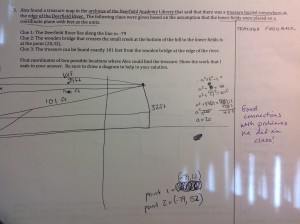
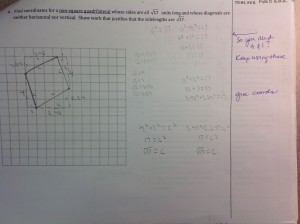
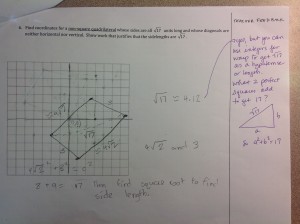
Some kids’ work warranted more writing and some warranted less. Of course if it was wonderful we just wrote something like, excellent work and perhaps wrote and extension question. The hard part was filling out the rubric. So for example, I’ll take Student 3’s work on problem 6 which is the last one above. Here is the rubric filled out for him:
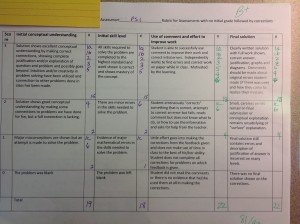
You will notice that I put problem 6 as a 1 for conceptual understanding and a 2 for skill level (in purple). In this problem students were asked to find a non-square quadrilateral with side lengths of sqrt(17). Student 3 was definitely able to find vertices of a quadrilateral, but he was unable to use the PT to find common lengths of sides. I gave him feedback that looking at sqrt(17) as a hypotenuse of a right triangle (as we had done in class) would help a bit and even wrote the PT with 17 as the hypotenuse in the hope of stimulating his memory when he did the revisions.
The day of the revisions Student 3 was only capable of producing this:
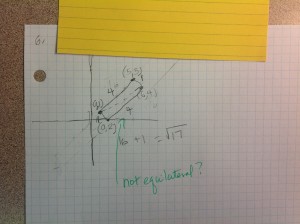
He followed my direction and used 4 and 1 (which are two integers that give a hypotenuse of 17, but did not complete the problem by getting all side lengths the same. In fact, conceptually he kind of missed the boat on the fact that the sqrt(17) was supposed to be the side of the quadrilateral altogether.
One success story was Student 2. She also did this problem incorrectly at first by realizing that you could use 4 and 1 as the sides of a right triangle with sqrt(17) as the hypotenuse but never found the coordinates of the vertices for me. I gave her feedback saying there might be an easier way to do this because she needed vertices. However, she was able to produce this:
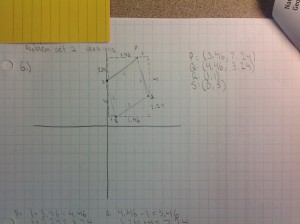
Although she did not give me integer-valued coordinates (which was not required) and she approximated which officially would not really give sqrt(17) lengths it came pretty darn close! I was impressed with the ingenuity and risk-taking that she used and the conceptual knowledge plus the skill-level. Yes, most other kids just used some combination of 1’s and 4’s all the way around but she followed her own thought pattern and did it this way. Kudos to student 2 in my book.
Next time I will talk about some of the lessons we learned, other artifacts from the kids’ work and what we are changing for next time! Oh yeah and some great martini recipes!
Carmel,
Thanks for sharing this. I can see why you are exhausted. I wanted to share something I am doing for the first time this year, which may or may not fit with your structure and philosophy, but here goes: For our first 9 week quarter, I wrote three exams covering the content we had covered up through week 5 (which was when our progress reports were due). The students took the first exam, received feedback and scores (I used Standard Based Grading and a 1-4 point scale). We continued working on new material for two weeks but then students took Exam 2 and received scores and feedback. The next week students took Exam 3 and received feedback and scores. I used the mode of the scores for each objective with an emphasis on the latest score (i.e. 2-4-4 would be given a “4”, 4-2-3 would be given a “3”, etc) to determine the score for each objective for the 9 weeks grade. While class time was not spent making corrections, students were invited before school to review their exams with each other and ask questions. Most students made nice improvements by the third exam. I look forward to seeing this work in our 2nd 9 week period, this time over more information (weeks 6-15 roughly). Thanks again for sharing, always a good read!
Joseph,
thanks for reading! This sounds very interesting – First, wow that sounds very organized. How did you fit 3 exams in five weeks? How much time did you have for that? When you say kids received scores and feedback, in what order? For me, that’s the important thing. I know I need the grade eventually for the administration but I want to focus on the feedback for my work with the kids. I am seeing more students right now Post-giving back the tests to go over the problems with them even though the know they can’t do anything to change the grade, then I did when I allowed them to do “corrections” – it’s pretty cool. I’m hoping too that there is improvement along the way in the writing of the revisions.
I’d love to hear more about how you determined what feedback to give them. thanks for sharing – Carmel
I think I wasn’t perfectly clear, the timeline looked like this:
Week 5: Exam 1
Week 7: Exam 2
Week 8: Exam 3
Each covered the first five weeks material. The students received scores after each exam, though not until they had read comments only. The understanding was also that the initial set of scores would not weigh as heavily as the subsequent scores. Hope that clarifies things a bit.
Joseph,
OK I see – so they had three assessments on the same material but only after receiving feedback. The third exam’s scores were weighted the most? Interesting method. Thanks for sharing.
3rd Exam counts the most. I have 8 or so standards in the first quarter for calculus, so each standard gets a 1-4 score on each exam. I used a combination of the mode / median and the latest score to determine the quarter score. I then averaged all the quarter scores to get a score on the 4.0 scale.
Hi Carmel,
First of all, great article. It’s easy for us as teachers to just give the students grades and not the feedback they need to succeed later. (After all, grades are all that seem to matter to students, anyway).
Anyway, I have one quick question about this strategy:
What type of assessments do you use this idea on? Is this for “tests” (I know you don’t call them that…), or homework, or for something totally separate?
Thanks!
And thanks again for the great conference this past summer! I’m using a lot of the strategies that I learned from you and the others who attended.
Hey Matt!
Great to hear from you! I hope your work with the kids is going well this year. In response to your question, my colleague and I decided to use this method only with the “major assessments” or what we call problem sets. We give about 4 of them a term. This term (which ends right at Thanksgiving for us) we only could fit three in because of our very late start this year (after Labor Day). We also give quizzes which are just “do you know this?” kind of assessment and of course we do our journal writing too. These major assessments take a lot of our time and energy so we feel like they are worth it. They assess a lot more than content knowledge but also problem solving skills so that’s why we separated the feedback into conceptual understanding and skill use.
Take care and thanks for reading!
Carmel